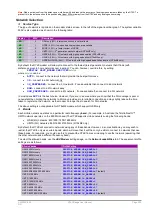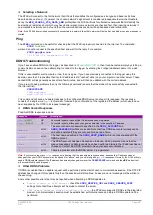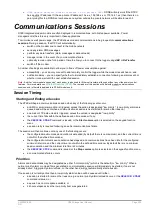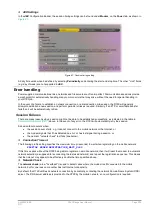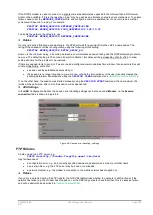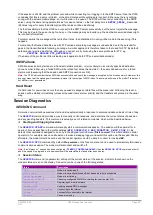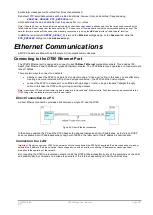
UM-0085-B09
DT80 Range User Manual
Page 219
RG
Signal Levels
In order to achieve reliable data communications using the integrated modem, it is important to ensure that the signal
levels are adequate.
The
DT80
's modem samples the signal level when connecting to the mobile network, and displays it on the modem
status screen in the form of 0-4 "bars". Note that the displayed signal level is not updated whilst the modem is connected.
The signal level may also be checked manually during operation using the
MODEM SIGNAL
command, as described in
.
Mobile signal power levels are reported in
dBm
, which measures the received signal power relative to a power level of 1
milliWatt. It is expressed in decibels, which is a logarithmic scale: an increase of 10dB is equivalent to a tenfold increase
while an increase of 3dB represents an approximate doubling (so 0dBm equals 1mW power while -100dBm represents a
power level of 10
-10
mW). For example, a signal level of -89dBm is roughly twice as strong as -92dBm.
For a cellular mobile device, the received signal level can be categorised as follows:
Signal level
Displayed bars Description
-113 dBm or less
□□□□
No signal – integrated modem is not usable.
-112 to -95 dBm
■□□□
Poor signal level. SMS will probably be OK, but an Internet connection will not be attempted,
unless you adjust the
MIN_SIGNAL_FOR_DATA_DBM
profile setting. You may
experience drop-outs and slow transfers.
-94 to -90 dBm
■■□□
Fair/marginal signal level
-89 to -72 dBm
■■■□
Good signal level
-71 dBm or more
■■■■
Excellent signal level
The
MODEM SIGNAL
command also reports the
bit error rate (BER)
, which is a measure of signal quality. A value of
0.1% is ideal, while a value of 15% or more is very poor. A high BER value is generally caused by interference, either
from electrical machinery or signal reflections off large objects such as hills or buildings.
Monitoring Signal Level
The system variable 82SV contains the measured signal level, as at the start of the current communications session.
This can then be logged or tested, the same as any other
DT80
channel. For example, the following will send an SMS
alert if the signal level is unexpectedly low (less than -90dBm in this example):
IF(82SV<-90)"Low signal: ?v dBm"[sms:+61400123456]
Continuous Signal Check Mode
During system commissioning, it can be helpful to know the instantaneous signal strength – as you position the antenna,
for example. The
DT80
provides a special mode for this purpose.
To select this mode:
1.
Select the modem status screen on the display. It should indicate
Modem is off
. If a session is already in
progress then you will need to terminate it by pressing
Func
, then selecting
Stop comms
.
2.
Press
Func
to bring up the function menu
3.
Select
Check signal
.
A session will now start. Once the modem registers, the signal strength and bit error rate will now be displayed on the
modem status screen in place of the IP address, e.g.
Telstra 3■■■□
-81dBm 0.14%
The information on this screen (and the system variables 80..84SV) will now be updated every few seconds.
For more information, see
.
Manual Display Update
If you select the
Check signal
option on the function menu while a communications session is in progress then this will
cause the displayed mobile operator name and signal level (number of bars) to be updated (once only).
Improving Signal Level and Quality
When commissioning the logger, you should always aim for a good to excellent receive signal level (3-4 bars).
If the measured signal level in your location falls into the fair to inadequate categories (0-2 bars), or if the BER value is
high, then you should take steps to try to improve it, e.g. by
•
relocating the antenna so it is more elevated
•
ensuring the antenna is not obstructed by metal objects
The
DT80
modem also supports
antenna diversity
. When in a poor signal area it is often helpful to connect a second
antenna to the left hand antenna socket. The two antennas should then be located a reasonable distance apart. The idea
is that the two antennas provide two diverse samples of the incoming signal, so if one suffers momentary interference or
signal fade then the other may still be adequate.
















